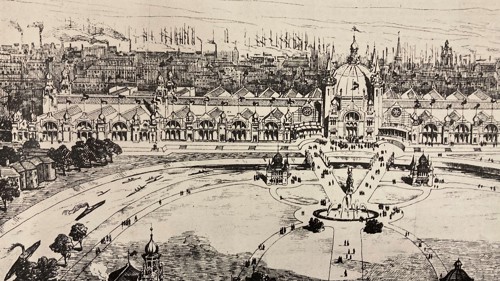1888 Exhibition - Times Past

Glasgow may have missed out on hosting the Eurovision Song Contest, but the city has a long history of staging major international events.
The first of these was the 1888 International Exhibition of Industry, Science and Art. This had two main aims: to showcase the city’s achievements in these fields and raise enough money to build an art gallery, museum and school of art.
Civic pride was a major motivating factor. Manchester held a similar event in 1887 and Edinburgh the year before that, so Glasgow was determined to uphold its reputation as the “Second City of the Empire” and put on a grand spectacle.
It certainly achieved this aim. Local architect James Sellars won the competition to design the exhibition buildings and transformed the Kelvingrove Park site into a striking oriental-themed wonderland dubbed “Baghdad by the Kelvin”.
The main building – constructed where the Kelvingrove Museum and adjacent tennis and bowling facilities now stand – was a quarter of a mile long and held the core exhibits. It contained thousands of displays including textiles, foodstuffs, musical instruments, fine art and, appropriately for Glasgow, shipbuilding. The “international” aspect of the Exhibition came largely from the Empire, with Indian and Canadian produce prominent.
Outside, the park was filled with attractions designed to appeal to a mass audience. An illuminated “fairy fountain” faced the Grand Entrance, its hundreds of water jets rising 150 feet high, and a switchback railway – an early version of a roller coaster – proved particularly popular. As well as celebrating the present and looking to the future, the Exhibition also took inspiration from the past. A reproduction of Glasgow’s Bishop’s Castle was built in the park and housed a collection of artefacts that celebrated Scotland’s history.
The Exhibition ran between May and November 1888 and recorded 5,748,379 visits. This total surpassed Manchester’s attendance by almost a million visits and was more than double that of Edinburgh’s, although there were reports of season ticket holders entering and leaving many times a day to increase the number of visits.
Accounting for two of these visits was Queen Victoria. The monarch formally attended the Exhibition when in Glasgow to open the new City Chambers (her first visit to the city since 1849) and returned for a private visit the following day.
By all measures the Exhibition was a roaring success. Financially, it raised a large sum towards the creation of the Kelvingrove Art Gallery and Museum. The much-loved attraction was opened in 1901 when Glasgow hosted its next international exhibition. It also succeeded in presenting a very different image to the smoky, squalid industrial city of popular imagination, although many of these challenges remained.
In one sense the Exhibition was temporary: the buildings were designed as impermanent structures and were dismantled after it closed. However, it left a lasting legacy in the shape of the museum it funded and, perhaps more importantly, a renewed sense of civic pride that drove Glasgow forward in the succeeding decades.
